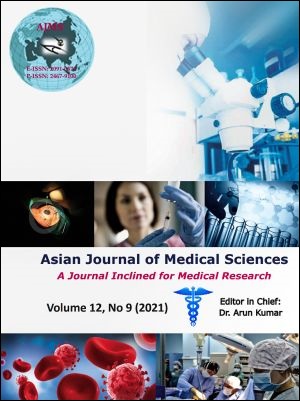Association of intrinsic factors with non-contact low back pain among fast bowlers aged between 15-19 years in division 1 boys’ schools in Colombo
Keywords:
Intrinsic factors, Non-contact low back pain, Fast bowlers, Age 15-19 yearsAbstract
Background: Cricket fast bowlers are identified as the players with a higher risk of injury due to their susceptibility to develop low back pain (LBP).
Aims and Objective: This study aims to investigate how intrinsic factors associate with LBP among fast bowlers aged between 15-19 years in Colombo division 1 boys’ schools in Sri Lanka.
Materials and Methods: A descriptive cross-sectional study was conducted with one hundred and two (102) fast bowlers who were prospectively monitored over the competition period of 2019 cricket season and the demographic data, severity of LBP, general characteristics and intrinsic factors related data were recorded.
Results: Thirty-seven (43.5%) of the subjects were presented with LBP. Reduction of quadriceps strength of dominant side, hamstring strength of non-dominant side and increased ankle dorsiflexion of non-dominant side were found to be significantly associated with non-contact LBP (P<0.05). There were significant differences for the quadriceps strength of dominant side and hamstring strength and ankle dorsiflexion of non-dominant side between the fast bowlers with and without LBP.
Conclusion: The results concluded that reduced quadriceps muscle strength of dominant side, reduced hamstring muscle strength and higher ankle dorsiflexion of non-dominant side have an important role in predisposing a fast bowler to have an increase in non-contact LBP.
Downloads
Downloads
Published
How to Cite
Issue
Section
License
Copyright (c) 2021 Asian Journal of Medical Sciences

This work is licensed under a Creative Commons Attribution-NonCommercial 4.0 International License.
Authors who publish with this journal agree to the following terms:
- The journal holds copyright and publishes the work under a Creative Commons CC-BY-NC license that permits use, distribution and reprduction in any medium, provided the original work is properly cited and is not used for commercial purposes. The journal should be recognised as the original publisher of this work.
- Authors are able to enter into separate, additional contractual arrangements for the non-exclusive distribution of the journal's published version of the work (e.g., post it to an institutional repository or publish it in a book), with an acknowledgement of its initial publication in this journal.
- Authors are permitted and encouraged to post their work online (e.g., in institutional repositories or on their website) prior to and during the submission process, as it can lead to productive exchanges, as well as earlier and greater citation of published work (See The Effect of Open Access).




